UNIVERSITY OF MONTEVALLO
https://jaredragland.com/montevallocontents:
PORTFOLIO OF RECENT WORK
Portfolio features project statements and full image captions. Further examples of work can be found in the linked projects in the website menu, along with links to recent news and a bio/cv.
PORTFOLIO OF STUDENT WORK
Portfolio features student outcomes, sample syllabi, and student + peer reviews.
.....................................
PORTFOLIO OF RECENT WORK
WHAT HAS BEEN WILL BE AGAIN
(2020-2022)
From Indigenous genocide to slavery and secession, and from the fight for civil rights to the championing of MAGA ideology, the national history written on, in, and by the people and landscapes of Alabama reveal problematic patterns at the nexus of our larger American identity. Photographed at a critical moment of pandemic and protest, economic uncertainty, and political polarization, What Has Been Will Be Again has led photographer Jared Ragland across more than 25,000 miles and into each of Alabama’s 67 counties to survey his home state’s cultural and physical landscape. By tracing the Trail of Tears, Old Federal Road, and Hernando de Soto’s 1540 expedition route, What Has Been Will Be Again contends with Alabama’s centuries-long past and present-day issues, and strategically focuses on the importance of place, the passage of time, and the visual-political dimensions of remembrance to confront white supremacist myths of American exceptionalism.
What Has Been Will Be Again was initiated through a 2020-21 Do Good Fund artist residency, and is made with additional grants and support from the Magnum Foundation, Columbus State University, The Aftermath Project, Wiregrass Museum of Art, Coleman Center for the Arts, and the Alabama State Council on the Arts.
See additional works and list of project publications, exhibitions, and awards here.
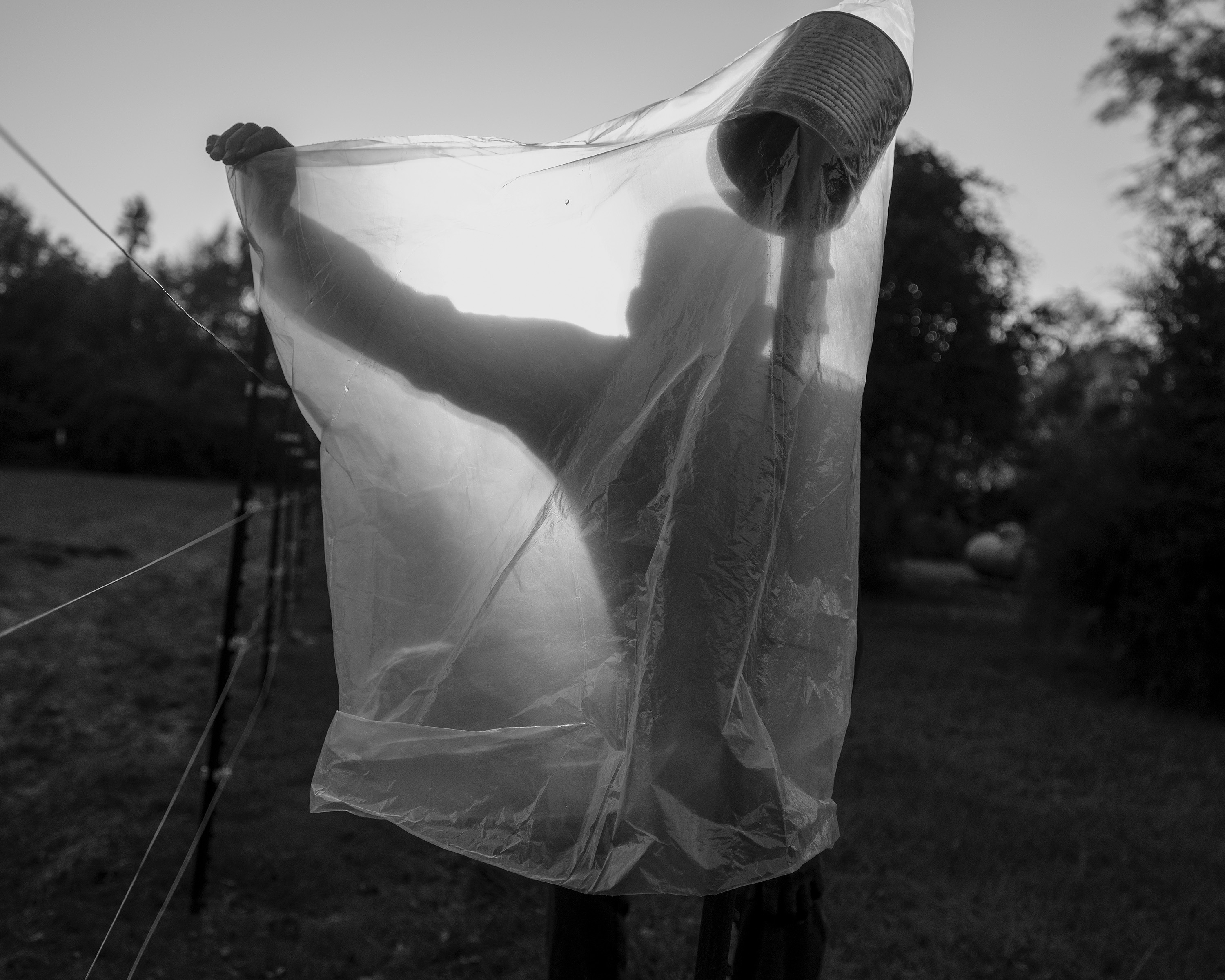
Spring Hill, Barbour County, Ala. Michael Farmer, 57, fashions a scarecrow next to his garden on Election Day
Archival pigment print, 21x24.5”
Michael Farmer’s family has lived in Spring Hill for generations, where the predominantly Black community has faced a history of racial violence and voter disenfranchisement. On November 3, 1874 a white mob attacked the Spring Hill polling station, destroying the ballot box, burning the ballots, and murdering the election supervisor’s son. Farmer is a lifelong Democrat and military veteran who served two tours overseas in Operation Desert Storm and Operation Iraqi Freedom. When asked what he hoped might come from the 2020 presidential election, Farmer said, “I hope the young folks might think about what their ancestors came through to get where we are.”

Childersburg, Talladega County, Ala. Sunshine turns soil in the Commons Community Workshop garden
Archival pigment print, 21x24.5”
As a response to recent national division and the COVID-19 pandemic, Sunshine and her husband Rusty recently bought a home in Childersburg and created The Commons Community Workshop. Through their Fearless Communities Initiative they are building a community garden in a donated downtown lot, hosting trade days, and fostering relationships with their neighbors as a means of “celebrating solidarity and strength.” The couple invited me to find them on Facebook where Sunny posts Initiative announcements, vocalizes her opposition to mask wearing and vaccines, and shares her beliefs about global child sex trafficking networks, the threat of Marxism, and the coming of the end times.
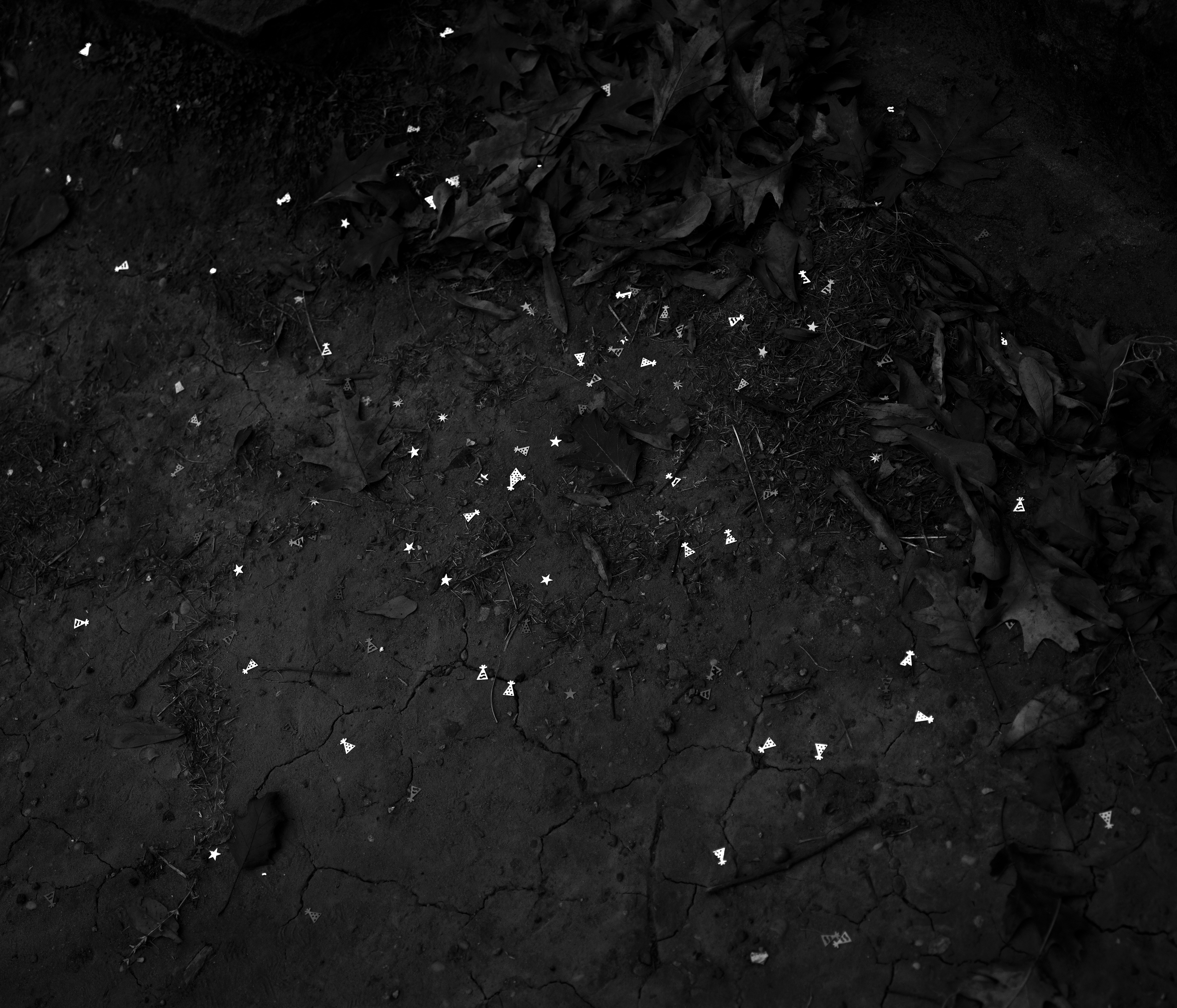
Tuscaloosa, Tuscaloosa County, Ala. Glitter scattered on ruins of the former Alabama state capitol building.
Archival pigment print, 21x24.5”
Yoholo-Micco, chieftain of the Upper Creek town of Eufaula, is said to have addressed the Alabama Legislature in 1836 at the state capital in Tuscaloosa before departing the ancestral Muscogee homelands on the Trail of Tears. Yoholo-Micco’s actual words are unknown, but white, colonial writers of history have portrayed the Creek leader as one who accepted Indigenous removal with an air of romantic resignation, going so far as to contrive his final words in a way to whitewash the genocide that had taken place over 300+ years’ time. Yoholo-Micco’s apocryphal address – which has been reproduced in Alabama history books and grade school curriculum for decades – reads, in part: “I come here, brothers, to see the great house of Alabama and the men who make laws and say farewell in brotherly kindness before I go to the far west, where my people are now going. In time gone by I have thought that the white men wanted to bring burden and ache of heart among my people in driving them from their homes and yoking them with laws they do not understand. But I have now become satisfied that they are not unfriendly toward us, but that they wish us well.”

Selections from the series What Has Been Will Be Again
Archival pigment prints, 21x24.5”

Selections from the series What Has Been Will Be Again
Archival pigment prints, 21x24.5”

Eastlake, Jefferson County, Ala. Jeremiah.
Archival pigment print, 21x24.5”
Bullock County, Ala. Along the Three Notch Road.
Archival pigment print, 21x24.5”
Built by U.S. Army engineers over the summer of 1824, the Three Notch Road was initially constructed to facilitate military communication between Pensacola, Florida and Ft. Mitchell, Alabama. Following Indian removal it became the major thoroughfare for those coming from Georgia into present-day Bullock County when eastern Alabama was opened to American settlement. Designated “Road No. 6” in official reports, the 233-mile path through a virtual wilderness was known and named locally for the distinctive horizontal notches blazed into trees by advancing surveyors as they marked the route for the builders who followed.
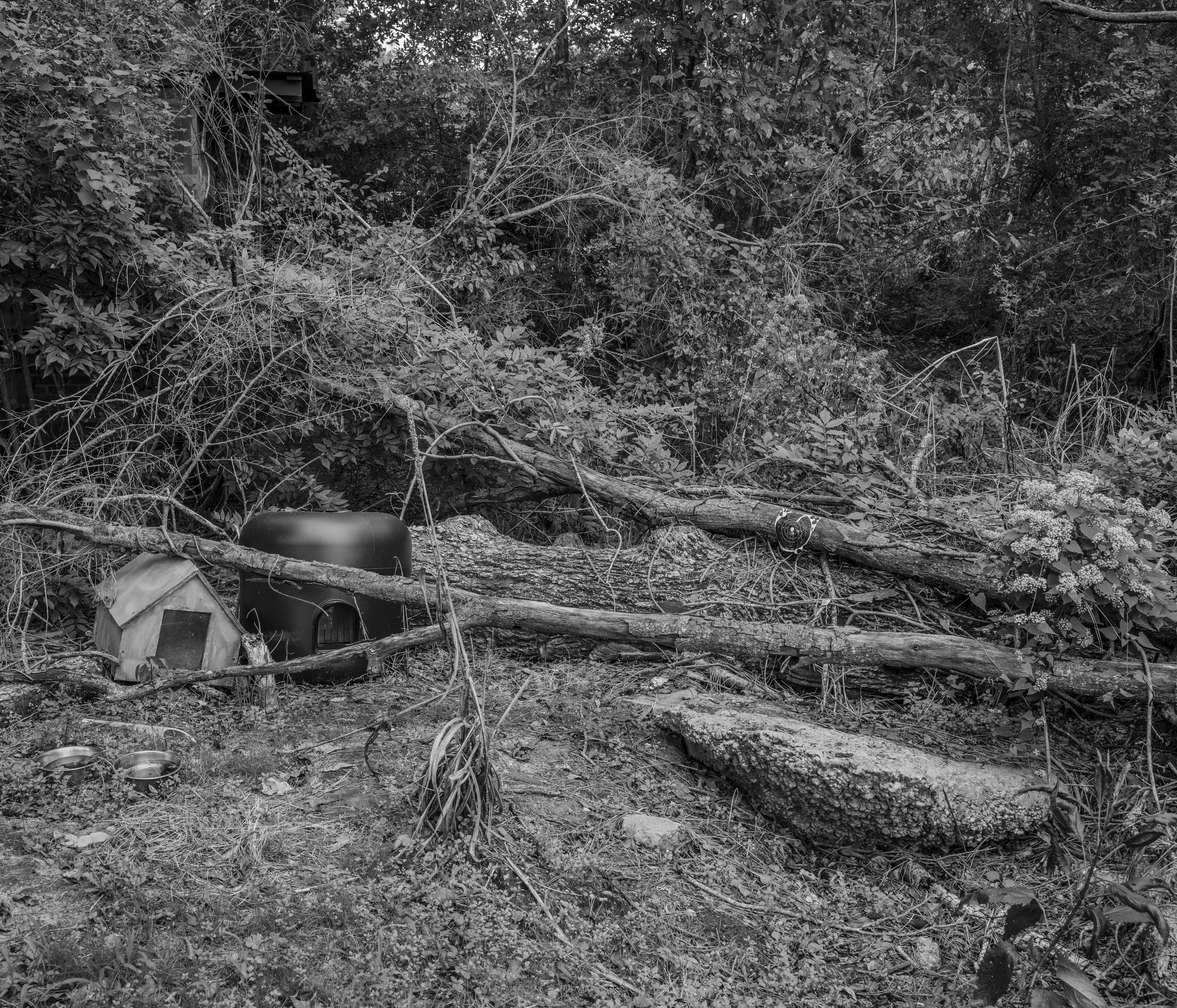
Hayneville, Lowndes County, Ala. Beside the former location of Varner’s Cash Store, where Civil Rights activist Jonathan Myrick Daniels was shot to death by Tom Coleman.
Archival pigment print, 21x24.5”
Jonathan Myrick Daniels, a white Episcopal seminarian from Keene, NH, had come to Alabama following Dr. Martin Luther King Jr.’s call for clergy to join the march from Selma to Montgomery. Daniels remained in Alabama after the march, assisting with voter registration efforts, working at a health clinic, and helping integrate an Episcopal congregation. In August 1965 Daniels and fellow activists attempted to purchase drinks at a Hayneville store but were held at gunpoint by volunteer special deputy sheriff Tom Coleman, who demanded they leave the property. Coleman shot at 17-year old African American activist Ruby Sales, but Daniels pushed Sales to the ground and took the impact of the blast, dying instantly. Coleman was charged with manslaughter in Daniels’ death, but an all-white jury acquitted Coleman of all charges after deliberating for less than two hours.
HELLBENDER
(2015-2019)
Photographed in collaboration with University of Alabama at Birmingham sociologist Heith Copes, Ph.D., Hellbender seeks to engage with the current conversation concerned with the pivotal political role and cultural identity of the rural American South and reveal how people who use meth create and communicate a sense of identity as they navigate social and economic marginalization.Southern Gothic literature has described the American South as a deeply flawed place, where the lives of eccentric characters are shaped by poverty, alienation, crime, and violence as they struggle through morally questionable actions to make sense of the world around them. The characters in stories by Flannery O’Connor, Carson McCullers, and Harry Crews often embody madness, despair, and decay to reflect social realities and critique conventional cultural understandings. Similarly, Hellbender tells the complex, often contradictory stories of more than two dozen people who use methamphetamine from Sand Mountain, a sandstone plateau in northeast Alabama infamous for extreme poverty, poultry processing plants, Pentecostal snake-handlers, and meth production. Through the combination of first person accounts, ethnographic interview texts, research analysis, documentary photographs and participant-made images, the project introduces the stories of Chico, an ex-convict, meth dealer, and self-proclaimed member of the Aryan Brotherhood; Ryan and Alice, a young runaway couple on the brink of a lifetime of addiction; Willow, a transient, chronic binge user; and Fred, a long-time user who lost everything he owned in a house fire.
See additional works and list of project publications, exhibitions, and awards here.
Michael, 8, from the series Hellbender: Methamphetamine Use on Sand Mountain, Marshall County, Alabama, 2015-2019
Archival pigment print, 16x24”
Michael is the son of meth users. The first time Michael’s mother, Misty, used meth she went on a five day binge. On the fifth day she woke up to find her oldest son drowning in the bathtub. The boy was resuscitated, but soon after he and two other children were taken from Misty’s care. Michael is the only child who remained in her custody. Today, Michael and his mother no longer live on Sand Mountain; Misty is drug-free and her oldest son was just accepted into the University of Alabama.
Willow, 38, from the series Hellbender: Methamphetamine Use on Sand Mountain, Marshall County, Alabama, 2015-2019
Archival pigment print, 16x24”
Willow tries to inject but struggles to find a vein, sticking herself half a dozen times before blaming me for making her nervous with the camera. Willow is a chronic binge user who lived in more than six homes in less than nine months.
Ryan, 22, from the series Hellbender: Methamphetamine Use on Sand Mountain, Marshall County, Alabama, 2015-2019
Archival pigment print, 16x24”
Upon his release from jail Ryan walked more than 20 miles from the sheriff’s office to his parent’s house in a neighboring county. He had served three months for stealing from friends, family and strangers to support his meth habit. While in jail he found Jesus, became a born again Christian and swore off meth, but he was turned away by his father when he arrived back home. After reuniting with his ex-girlfriend, Alice, he moved into a trailer with her and began using again, this time with needles. Ryan recently moved away from Sand Mountain and is living drug-free.
Mono, 40, from the series Hellbender: Methamphetamine Use on Sand Mountain, Marshall County, Alabama, 2015-2019
Archival pigment print, 16x24”
Mono arranges clothes for a garage sale. Together with another user, he sold just enough to buy a quarter gram of meth, hardly enough to split and both get high. “Meth makes me forget about my problems, it makes me not think about them. Look, I might use and all that, but… I’m one of the good bad people. I’m a good, bad person. That’s what I tell everybody.”

Selections from the series Hellbender: Methamphetamine Use on Sand Mountain, Marshall County, Alabama, 2015-2019
Archival pigment prints, 16x24” each
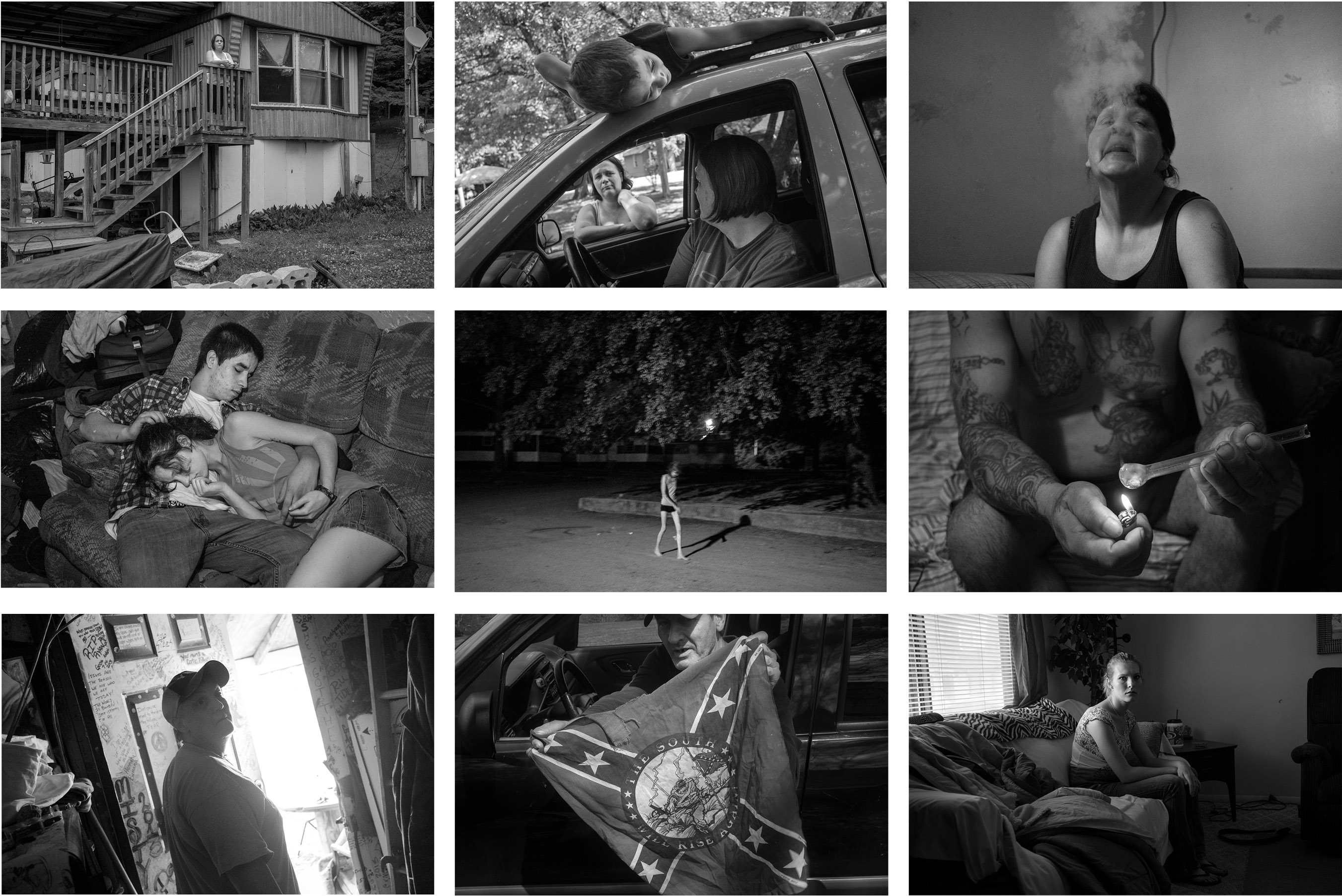
Selections from the series Hellbender: Methamphetamine Use on Sand Mountain, Marshall County, Alabama, 2015-2019
Archival pigment prints, 16x24” each
SOME MILLION MILES
(2019)
Set within a rural landscape of abundant beauty and deep poverty, Some Million Miles presents a meditation on loss and the search for redemption amidst systemic social and economic marginalization. Through a series of confessional vignettes, the film reconnects viewers to the stories Chico, Alice, and Misty several years after their participation in the photo-ethnography project, Good Bad People. As Chico struggles with reintegration into society following a jail sentence, Alice pursues recovery and fights for custody of her daughter while Misty rebuilds a stable life after ending an abusive relationship. Some Million Miles is co-directed with filmmaker Adam Forrester, was produced with support from an Indie Grits Rural Project grant, and was distributed by Reel South via PBS.To view the full film via PBS online: https://www.pbs.org/video/some-million-miles-zlgpox/
See full credits and list of film screenings here.
Trailer for the short documentary film, SOME MILLION MILES, 2019 (co-dir. Adam Forrester)
WHERE YOU COME FROM IS GONE
(2017-2020)
Where You Come From is Gone explores the importance of place, the passage of time, and the political dimensions of remembrance through the historical wet-plate collodion photographic process. Created during the state of Alabama’s bicentennial celebration with collaborative partner Cary Norton, the large scale images seek to make known a history that has largely been eliminated and make visible the erasure that occurred in the American South between Hernando de Soto’s first exploitation of native peoples in the 16th century and Andrew Jackson’s Indian Removal Act 300 years later.Using a 100-year-old field camera and a custom portable darkroom tailored to a 4x4 truck, Norton and I have journeyed more than 3,000 miles across 30 Alabama counties to locate, visit, and photograph indigenous sites. Yet the melancholy landscapes hold no obvious vestiges of the Native American cultures that once inhabited the sites; what one would hope to document, hope to preserve, hope to remember, is already gone. Instead, the photographs deliberately document absence and seek to render the often invisible layers of culture and civilization, creation and erasure, and the man-made and natural character of the landscape.
See additional works and list of project publications, exhibitions, and awards here.
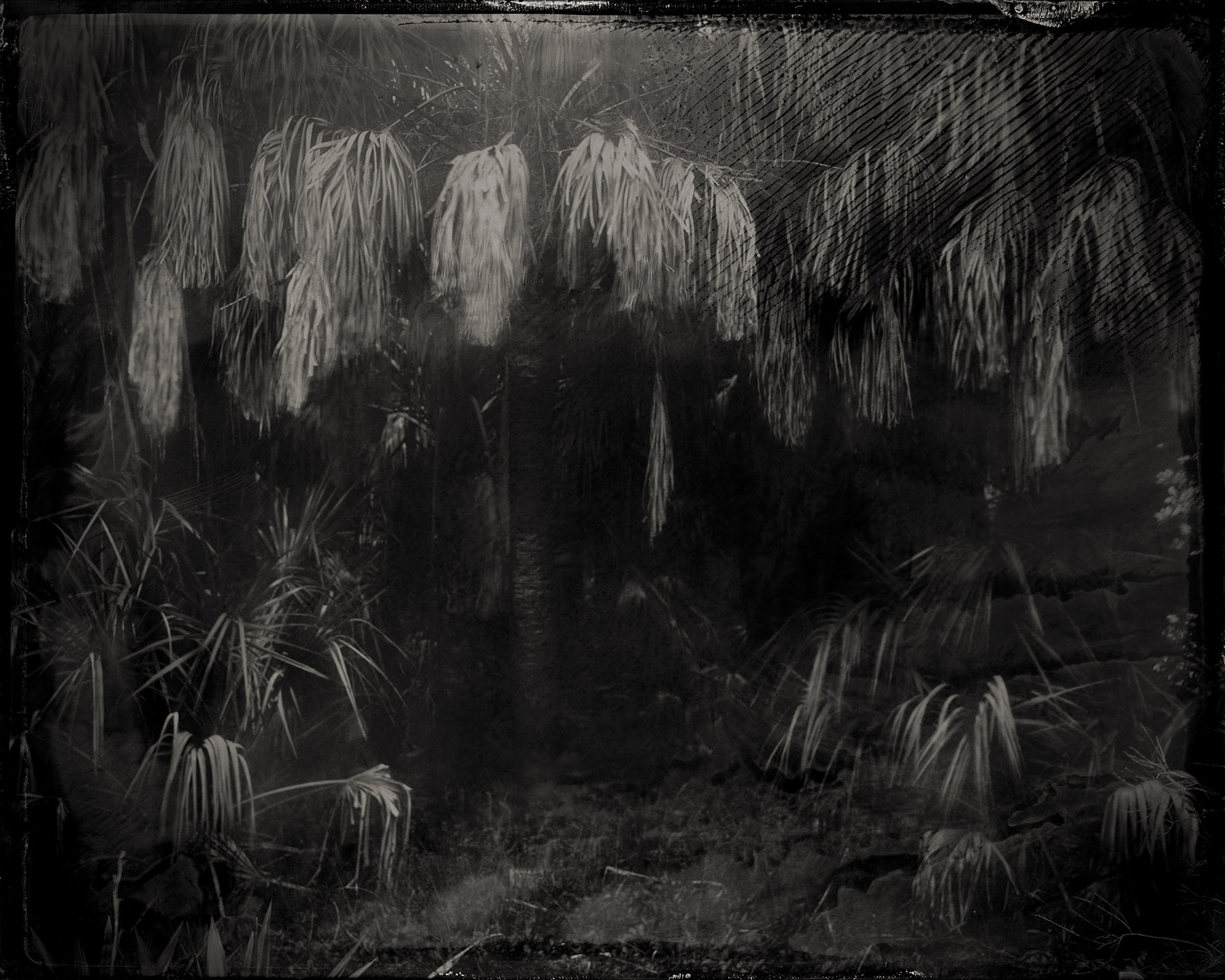
Egmont Key, Florida, from the series Where You Come From is Gone, 2020
Archival pigment print from wet-plate collodion tintype, 40x50”
Collaboration with Cary Norton, commissioned by the Leepa-Rattner Museum of Art
The United States government began forcibly removing Native Americans from Florida in 1817. As Eastern Woodland peoples throughout the southeast were forced to leave their homelands for reservations in Oklahoma, the Seminoles – an already displaced people – were removed by steamship in an over-water branch of the Trail of Tears. One such vessel, the Grey Cloud, made more than two dozen voyages during the Second and Third Seminole Wars from a stockade on Egmont Key, a small secluded island located in the mouth of Tampa Bay. At one time, the stockade held as many as 300 Seminoles, including Holata Micco (Billy Bowlegs), one of the last Seminole chiefs to resist forced removal; Emateloye (Polly Parker), who escaped the Grey Cloud while docked near Tallahassee and walked 400 miles southward to rejoin her people at Lake Okeechobee, where she lived until her death in 1921; and Seminole leader Thlocklo Tustenuggee (Tiger Tail), who committed suicide by swallowing crushed glass rather than remain in captivity. It is also said ten Seminole warriors detained at Egmont marched silently into the Gulf instead of suffering relocation. Many other Seminoles died while interned on the island, but names and burial locations were not accurately recorded by the US government. Over the last century, Egmont Key has lost more than half its land mass – and with it its important history – as the seas surrounding the island have risen at least 8 inches. State officials predict another 9- to 24-inch rise by 2060, while wakes churned by fuel tankers, container ships, and cruise liners in Tampa Bay increasingly erode the island’s dunes.
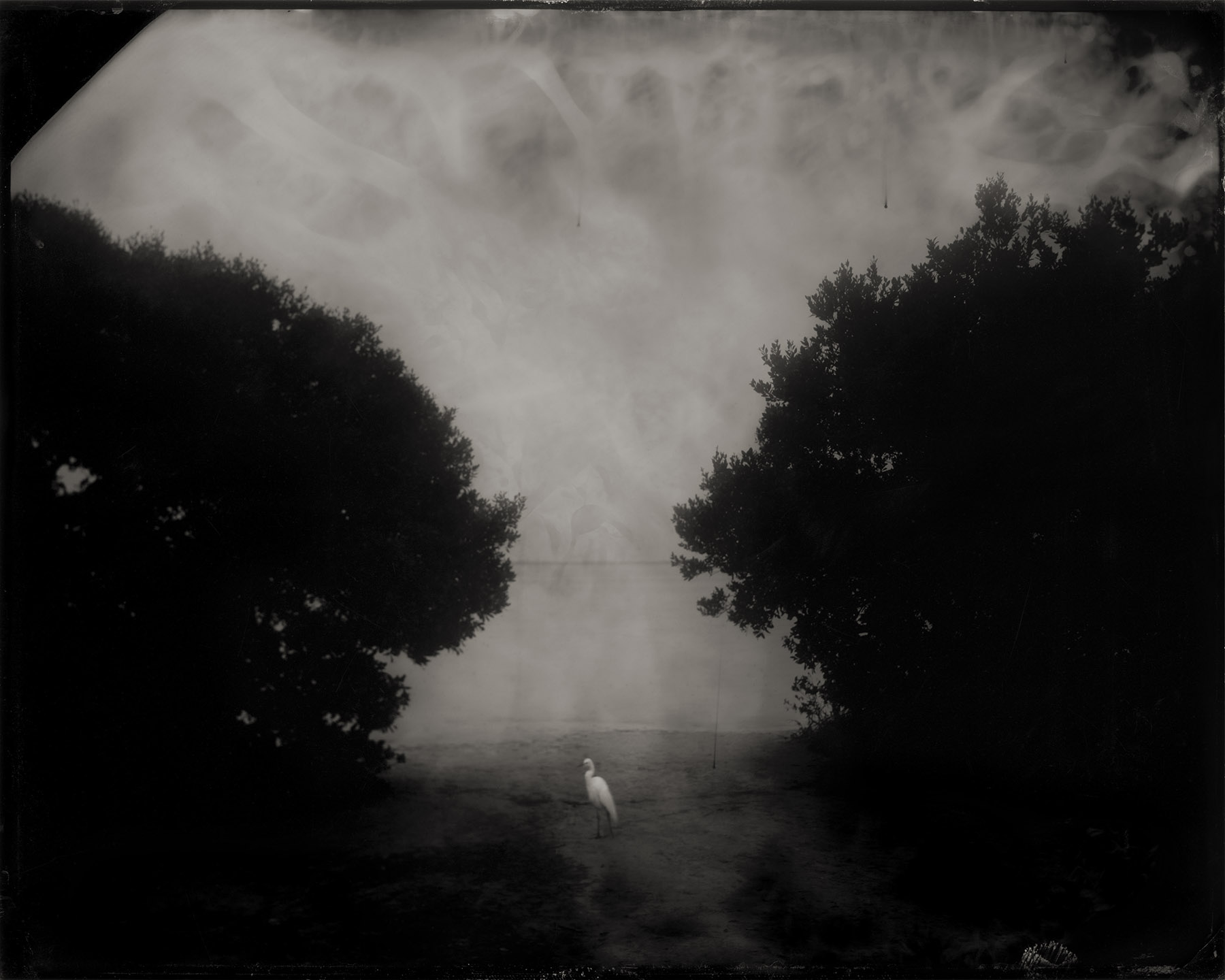
Tierra Verde, Florida, from the series Where You Come From is Gone, 2020
Archival pigment print from wet-plate collodion tintype, 40x50”
Collaboration with Cary Norton, commissioned by the Leepa-Rattner Museum of Art
Near this site, south of present-day St. Petersburg, a Tocobaga charnel house and burial mound were once situated on a series of 15 islands. Scholars believe the dead would be laid in the charnel house and a shaman/priest – with help from scavenging birds – would remove the flesh from the skeleton in preparation for burial. Once stripped or picked cleaned, the bones and the eternal spirit they held were placed in the mound. The Tocobaga disappeared from the historical record by the early 1700s, as disease brought by European explorers decimated the Safety Harbor culture, leaving the Tampa Bay area virtually uninhabited for more than a century. The landscape of Tierra Verde was completely transformed in the late 1950s when the burial grounds were razed and used as fill dirt for a residential development and golf course.

Cahaba River, Dallas County, Alabama, from the series Where You Come From is Gone, 2017
Archival pigment print from wet-plate collodion tintype, 40x50”
Collaboration with Cary Norton
For millennia people have been drawn to the land situated at the confluence of the Cahaba and Alabama rivers. The area now known as Old Cahawba was first occupied by large populations of Paleoindians 4,000 years ago. During the Mississippian period (1000–1500 CE), mound builders established a walled city with palisades that was visited by Spanish conquistadors in the 16th century. In the years that followed, Afro-Eurasian diseases the explorers brought with them killed thousands of Indigenous people, and the remaining native peoples were wiped out or forced to move by an even greater influx of Europeans. By the early 19th century, the dirt from the ancient mounds at Cahawba was used to build railroad beds, and the town briefly served as the state capital of Alabama. Cahawba became a ghost town shortly after the Civil War, largely due to recurring floods. By the late 1800s, the town site was purchased for $500 and its buildings demolished.
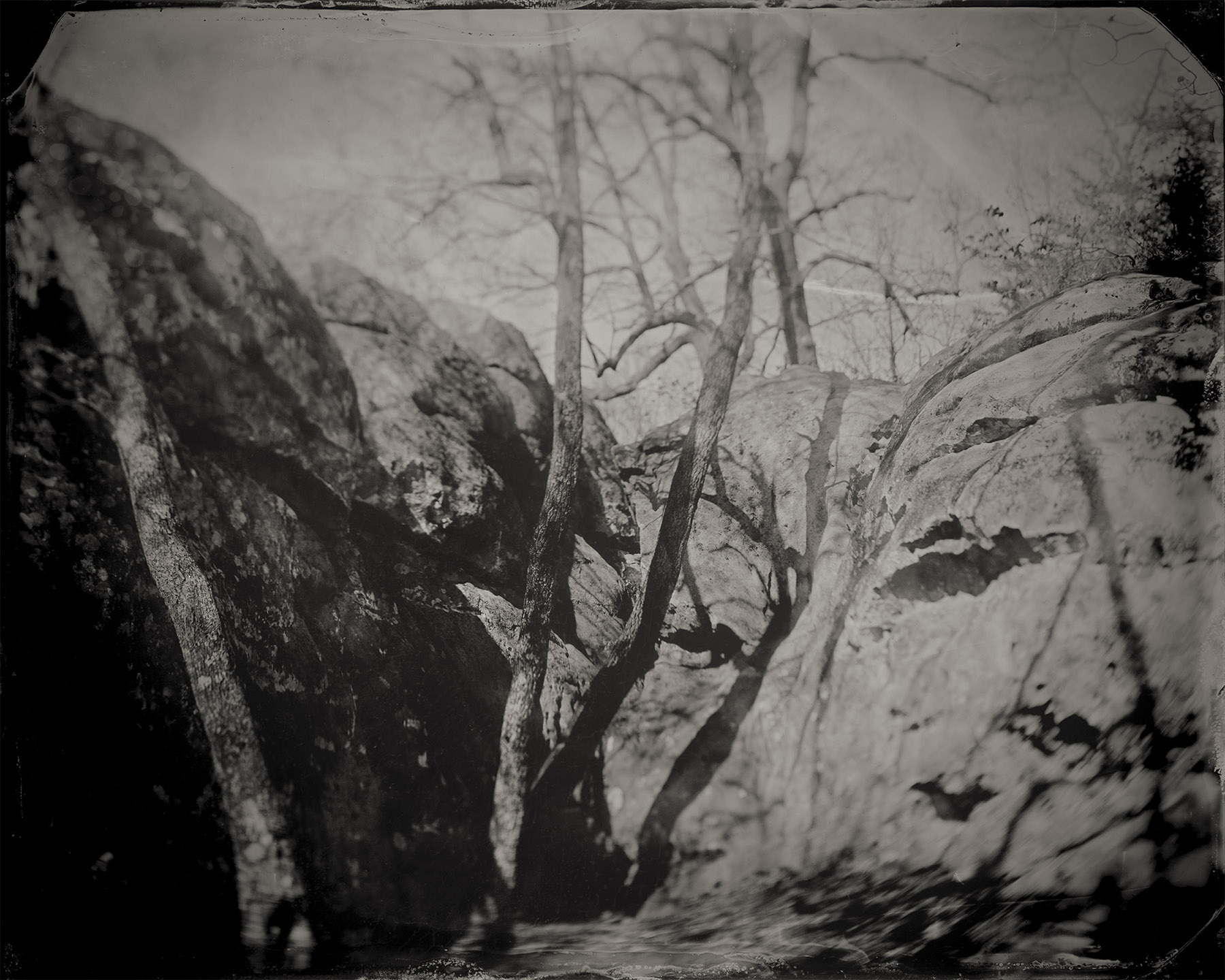
Cherokee Rock Village, Cherokee County, Alabama, from the series Where You Come From is Gone, 2017
Archival pigment print from wet-plate collodion tintype, 40x50”
Collaboration with Cary Norton
Cherokee Rock Village was home to Indigenous peoples almost continuously from 8000 BCE until the 1830s, when the resident Cherokee and Muscogee (Creek) peoples were forcibly removed by the Indian Removal Act. Located along an ancient Native American trail of religious and ceremonial importance, the site later became a starting point for the Trail of Tears.
ONE DAY PROJECTS
One Day Projects is a collaborative publishing platform committed to promoting creative dialogue by challenging artists to produce and publish innovative projects within a 24-hour time period. Established in 2015 with photographer/bookmaker Eliot Dudik, One Day Projects has produced three limited edition artist books: And light followed the flight of sound (2018); or give me death (2016); and bras-coupé (2015).On August 21, 2017, the total solar eclipse provided a rare opportunity for people across the United States to experience a collective encounter. Despite the prevalence of contemporary political and cultural polarization, more than 215 million Americans–88% of the country’s total population–stood side by side and looked skyward together, sharing in a quieting, unifying act.
Inspired by both the natural wonder and symbolic possibilities of this unique occurrence, photographers from inside and outside the path of totality were invited to document and share their experiences. The resulting book, And light followed the flight of sound, features 85 images by 52 emergent and established photographic artists. Edited, designed and produced with Eliot Dudik and presented as a 30-foot-long, hand-bound accordion with an enclosed saddle-stitched zine and essay by art historian Catherine Wilkins, Ph.D., the limited edition of 150 copies is printed on digital offset, covered in a foil-stamped cloth, and housed in a clear Mylar sleeve, also foil stamped. As the book is removed from its sleeve, the foil stamps mimic the passage of the moon in front of the sun.
See additional One Day Project information and publications here.

And light followed the flight of sound, 2018
30 foot-long hand-bound accordion book with saddle-stitched zine and mylar slip cover, featuring images by 52 photographers made on the 2017 total solar eclipse. Coordinated, edited, and bound in collaboration with Eliot Dudik as One Day Projects. Edition of 150
.....................................
.....................................
PORTFOLIO OF STUDENT WORK

Bailey Rigby, selections from The Study of Last Things
Pigment prints, various sizes, and found objects
Senior BFA thesis project and exhibition installation
Utah State University • Advanced Photographic Studio (Senior level) • 2023
baileyrigby.com
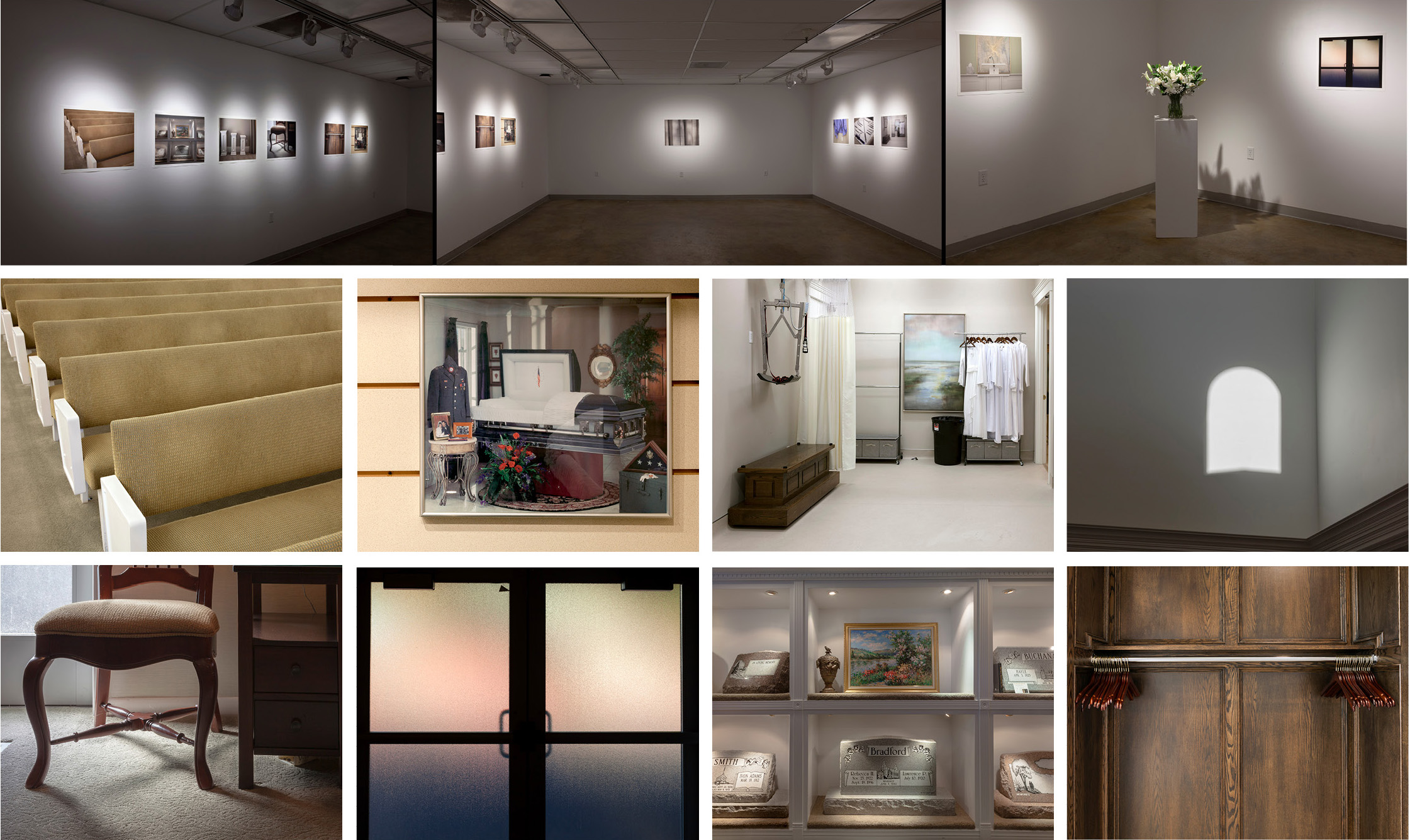
Victoria Johnson, selections from The body is only a vessel
Pigment prints, 16x20” each
Senior BFA thesis project and exhibition installation
Utah State University • Advanced Photographic Studio (Senior level) • 2023
victoriajohnson.art

Kennedy Fry
Pigment prints, various sizes
Utah State University • Advanced Photographic Studio (Junior level) • 2023

Lele Bonizzi
Pigment prints, various sizes
Utah State University • Advanced Photographic Studio (Junior level) • 2023
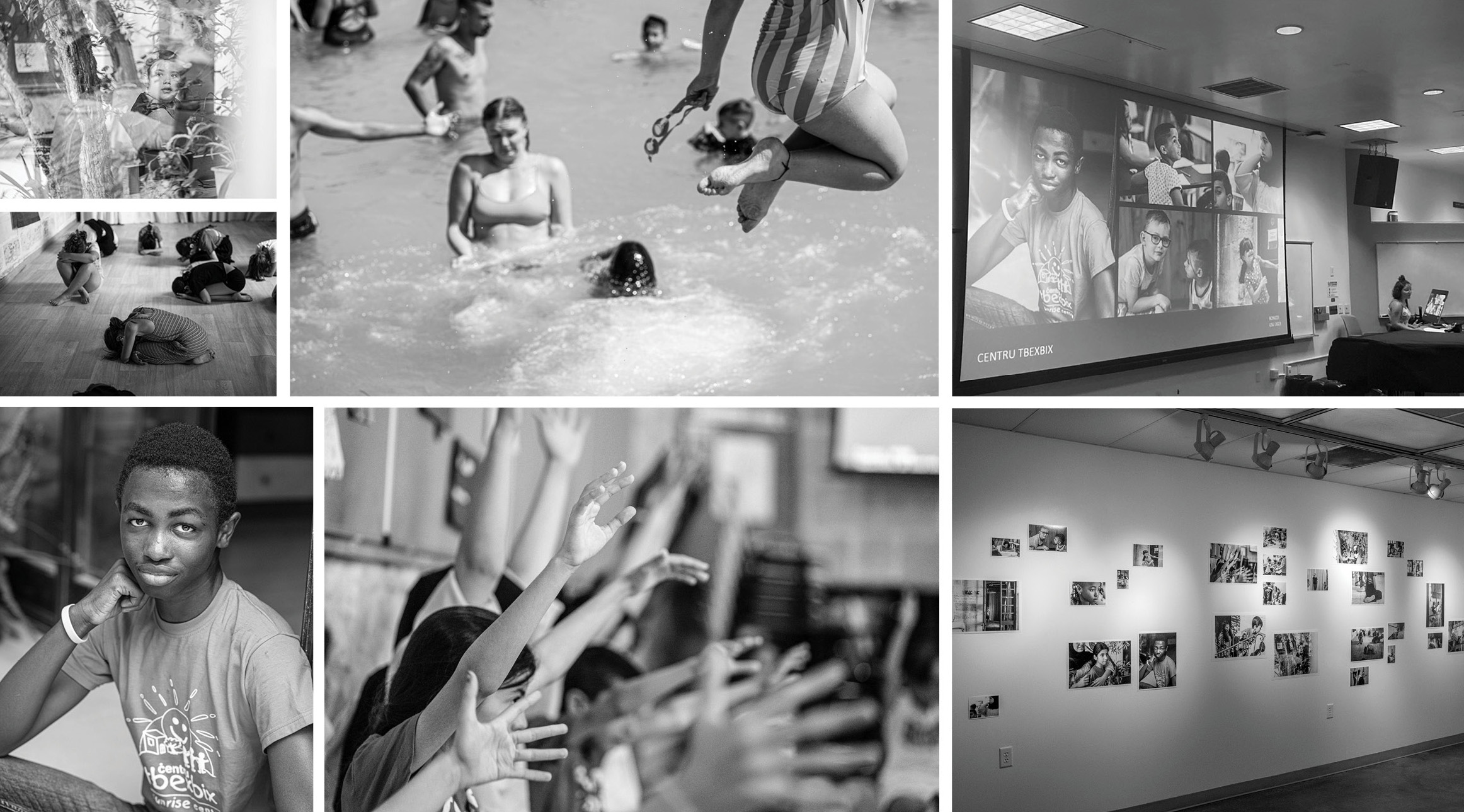
Lele Bonizzi, selections from Ānanda Mārga through the Lens of Malta: a Photographic Exploration
Pigment prints, various sizes
Documentary photographs, exhibition installation, and lecture documentation
Utah State University • Summer Arts Research Grant mentorship • 2023
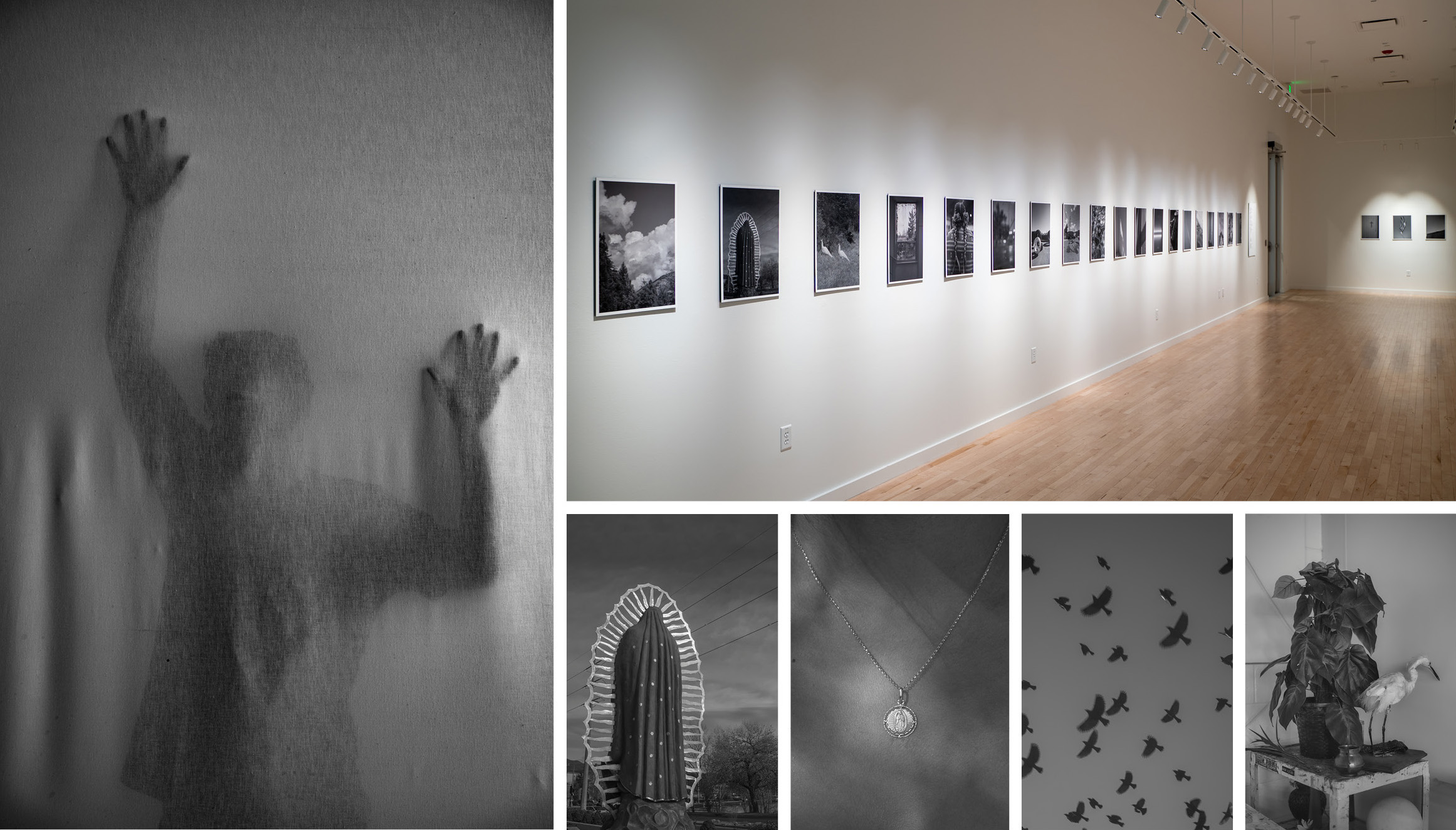
JC Santistevan, selections from Ni de aqui ni de alla
Pigment prints, 18x24” each
MFA Thesis project and exhibition installation
Utah State University • Master of Fine Arts Graduate Thesis Committee • 2023

Various artists, wet-plate collodion tintypes
Utah State University • Studio Lighting • 2022

Iris Wu, selections from an untitled series
Silver gelatin and inkjet prints, various sizes
College of William & Mary • Catron Scholarship Mentor Program • 2020
iriswuphoto.com

Aaron Canipe, selections from the series Plateau
Pigment prints, 20x24” each
MFA Thesis Project
Duke University • Master of Fine Arts in Experimental & Documentary Arts Graduate Thesis Committee • 2015
aaroncanipe.com

Celestia Morgan, selections from the series Redline
Pigment prints, various sizes
MA Thesis Project
University of Alabama • Master of Arts Thesis Committee • 2016
celestiamorgan.com
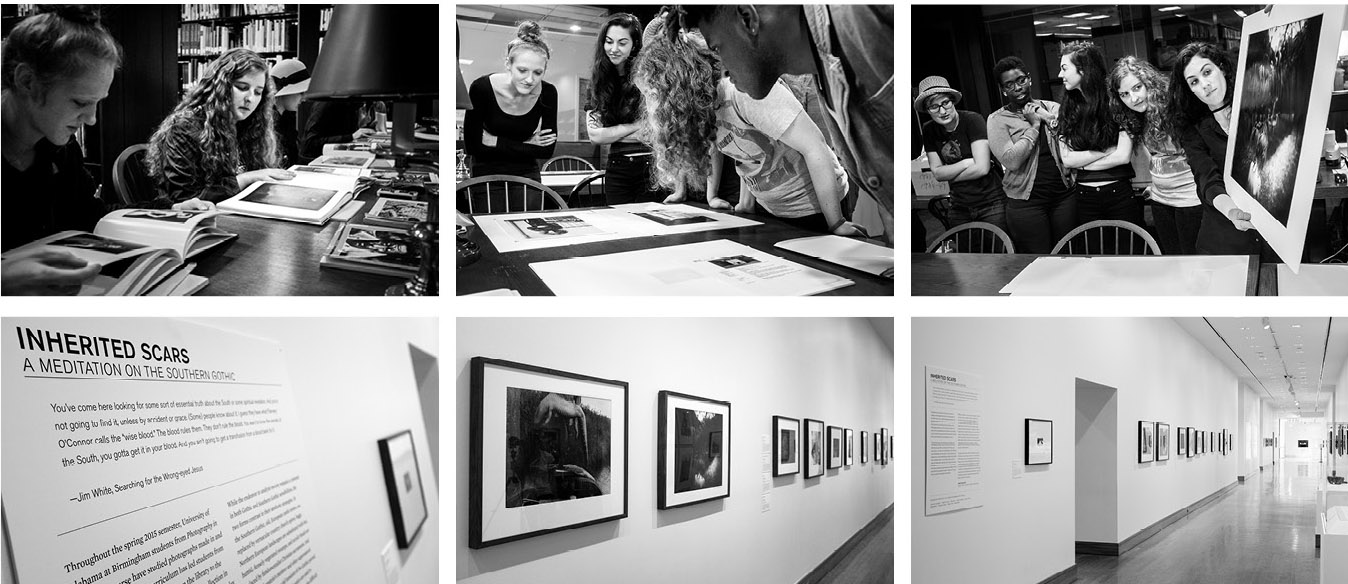
Documentation of the student curated exhibition, Inherited Scars: A Meditation on the Southern Gothic
Birmingham Museum of Art, April 2 – August 9, 2015
University of Alabama at Birmingham • Special Topics: Photography in the South • 2015
https://www.artsbma.org/exhibition/inherited-scars-a-meditation-on-the-southern-gothic/

Devin Lunsford, selections from the series Waiting for Something That’s Not Coming
Pigment prints, 6x6” each
Course Final Project
University of Alabama at Birmingham • Special Topics: Photography in the South • 2015
devinlunsford.com

Ty Harris, stills from Hymns of Youth
Video, 3 minutes
Course Final Project
University of Alabama at Birmingham • Special Topics: Photography in the South • 2015

Selection of student artist books and zines accessioned into the Birmingham Museum of Art Hanson Library Artist Book Collection
University of Alabama at Birmingham • Special Topics: Camera-less • 2016
https://uab.edu/news/self-published-artist-books-and-zines-made-by-uab-students-now-part-of-birmingham-museum-of-art-collection
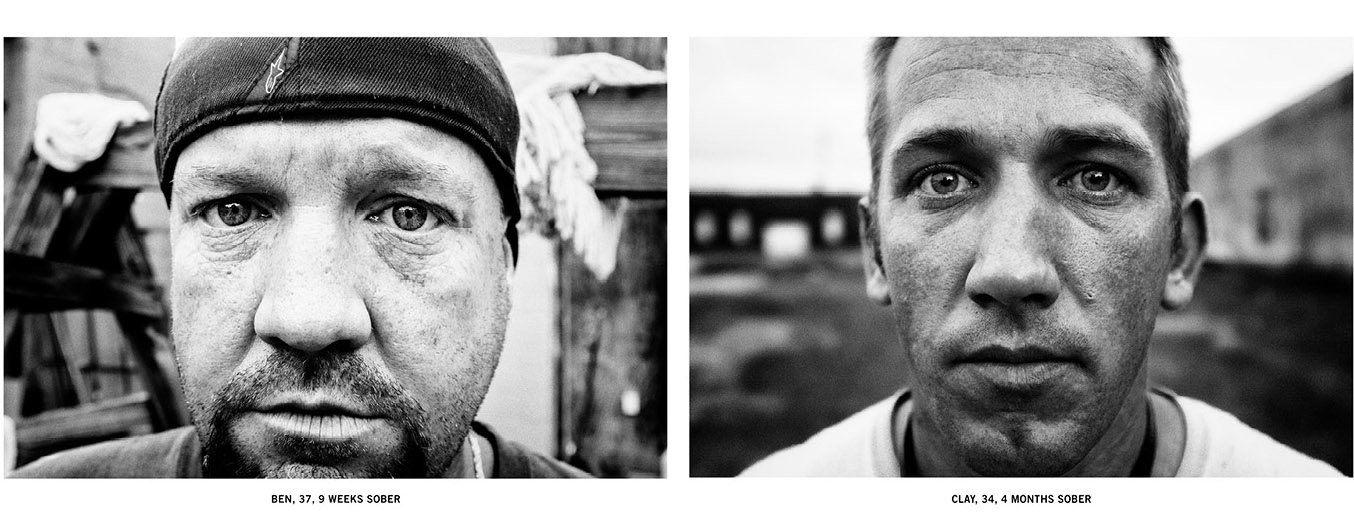
Devin Lunsford, selections from the series, Done Lost Too Much
Pigment prints documenting recovering methamphetamine cooks, made in collaboration with UAB Department of Criminology student Natalie Matos, 16x24” each
Course Final Project
University of Alabama at Birmingham • Special Topics: Stories from the Line – Documenting Poverty • 2015
devinlunsford.com

Cole Martin
Silver gelatin prints, 6x6” each
Self-portrait Assignment
University of Alabama at Birmingham • Experiential Photography • 2018

Eric Gregory Powell, selections from the series Route 1
Pigment prints, 16x20” each
BFA Thesis Project
Corcoran School of the Arts + Design, George Washington University • Studio Photojournalism Core IV Senior Thesis • 2007

Jessica Kolscielniak, selections from the series Weighted Decisions
Pigment prints, 16x24” each
BFA Thesis Project
Corcoran School of the Arts + Design, George Washington University • Studio Photojournalism Core IV Senior Thesis • 2007
jessicakoscielniak.com

Sara J. Winston, selections from the series Chronicles
C-prints, 8x8” each
Sequencing and Narrative Assignment
Corcoran School of the Arts + Design, George Washington University • Studio Fine Art Photography Core III • 2010
sarajwinston.com

Justine Tobiasz, selections from the series Strike, Gently
Gum bichromate prints with blood, 16x20” each
Sequencing and Narrative Assignment
Corcoran School of the Arts + Design, George Washington University • Studio Fine Art Photography Core III • 2008
justinetobiasz.info
SAMPLE SYLLABI
Advanced Photographic Studio
Utah State University • 2023
Download: Ragland ART 4885 Advanced Photographic Studio.pdf
Students focus on refining skills for building a personal and professional portfolio. The course provides structured time, guidance, and facilities for advanced photo students to develop their voice and vision and build toward their BFA thesis projects.
The Compassionate Image: Socially-Engaged Visual Storytelling
University of South Florida Judy Genshaft Honors College • 2020
Honors Capstone credit course certified by the USF Honors College for “Integrative & Applied Learning: High Impact Practice.”
Download: IDH 4950_005_Ragland.pdf
The Compassionate Image: Socially-Engaged Visual Storytelling was a visual arts-based interdisciplinary honor's capstone course focused on the crafting and critical understanding of photographic images in context of urban planning, ethnographic studies, and the local Tampa community. The class was taught in collaboration with IDH 3400-013 Fostering a Compassionate City: Systems Thinking for Social Change, and IDH 4950-004 Compassionate Cities: An Emerging Social Development, and students from each class built three-person teams to collaborate on semester long, community-engaged visual capstone projects within Tampa’s University Area neighborhood.
Special Topics: Photography in the South
University of Alabama at Birmingham • 2015
Download: Ragland-Photography in the South-Syllabus.pdf
Photography in the South led students from the classroom to the studio and from the library to the museum, in search of an understanding of the South and the complex ways in which it has been pictorially represented through fine art and documentary photographic practices. In tandem with their studio assignments and coursework, students conducted individual and team-based research inside the Birmingham Museum of Art and worked with Wassan Al-Khudhairi, former Hugh Kaul Curator of Modern and Contemporary Art, and former BMA Librarian Lindsey Reynolds, to jointly curate a public exhibition of Southern photographs from the permanent collection.
Over a period of eight weeks, students mined the BMA’s holding of photographs, collectively chose an exhibition theme, and worked step-by-step to research images and artists, creating wall text and labels, and coordinated the installation. Eleven photographs were selected for the exhibition, and Inherited Scars: A Meditation on the Southern Gothic opened at the Birmingham Museum of Art in April, 2015. The students served as gallery docents at the museum, and the exhibition served as a focal point for museum public programming, including a storytelling event, Storytelling and Southern Identity with Members of the Moth Radio Hour.
In addition to the BMA exhibition, students also exhibited their personal creative work in a group show at UAB’s Visual Arts Gallery that then traveled to the Shelby County Arts Council in Columbiana, Ala.
The PDF syllabus also contains student evaluations, an article on the BMA curatorial project for Focal Plane Magainze, and a press release for the students’ exhibition, Accidental Grace: Photographs Made in and About the South.
PEER TEACHING EVALUATIONS
(Full peer teaching evaluation letters available upon request)Jared is an effective instructor, communicator, and scholar. His enthusiasm for the subject matter was apparent. He was confident, relaxed, and articulate. He provided examples to aid in student understanding. Ragland’s content mastery, breadth, and depth of this material were outstanding. He is effective in getting students to engage in thoughtful conversation. I would venture and conclude that Ragland is a master teacher. I could not have been more impressed.
– Darrin Brooks • Professor, Utah State University • 2023
Jared is a constant positive presence, moving around, asking questions, encouraging thinking and thoughtful responses. The students were highly engaged and talkative and not only had excellent responses to the issues raised by Jared but with the questions and issues they raised amongst themselves and from the set readings. The back and forth and genuine engagement with the material, with each other, and with Jared was perhaps the most impressive feature of this class. It is a testament to his teaching style that he has clearly created an environment in which his students feel very much at ease to discuss, to question, and engage in ways that are serious but relaxed at the same time... Jared is an excellent instructor, great with his students, knowledgeable and enthusiastic but clearly rigorous in his expectations in the best possible way.
– David Wall, Associate Professor • Utah State University • 2023
Ragland’s instruction is student-centered, positive, and result driven... I can say with certainty that Ragland is first-rate educator. In fact, if I were to evaluate his teaching in comparison with the faculty in my department, several of whom are excellent teachers and consistently receive positive evaluations and strong student critiques, I would place Ragland at the top. Given my experience, educational knowledge, and what I have seen in-person, I find Ragland’s performance as a teacher to be exemplary.
– William Fenn • Chair + Associate Professor, Department of Fine Arts, Auburn University at Montgomery • 2023
STUDENT REVIEWS + RESPONSES
I found that Professor Ragland’s teaching style prepared me to critically think and create outside of a classroom. The readings and discussions we had in class were some of the best of my academic career, and I will be utilizing the knowledge I gained from this class for the rest of my life. I wish I got to take classes with Jared before my junior year, as I believe I would have been able to understand my own work sooner. He has been a phenomenal mentor and I look forward to continuing to learn from him after I graduate.
– Advanced Photographic Studio • Utah State University • 2023
He’s demanding and he expects a lot from his students, but I can attest that he has made me a much better artist. His passion can be intimidating but it inspires us all to do our best, which was much needed in the photo department. I think he’s exactly what the program needed, and I’m honored to have him as my professor.
– Advanced Photographic Studio • Utah State University • 2023
I can confidently say that Jared’s mentorship has been the pivot in my academic experience, and has been unlike anything I have received during my four years at Utah State. ...Jared was able to help me get on the right track from the beginning by providing plentiful resources, which ultimately made the project, one heavy and complex in nature, sophisticated and smart. ...I also felt that finding pieces of literature, cinema, and other historical references made my project feel more articulate. Our class critiques were a vital part of the process. I never left critique feeling down or discouraged about my work–oftentimes I left feeling encouraged and excited about what was next. We were never told to just “try harder,” but instead were given specific ways to work through our problems and frustrations. Jared was always willing to meet with us outside of our allotted class time. There were some weeks where we met most every day to work on things such as framing for exhibitions, writing about our work, or prepping for photo opportunities. He was even able to help us get to Denver for the Society for Photographic Education conference so we could hear different types of artist talks and make connections with other photographers and grad programs. I am incredibly happy about the way this class has gone and how my thesis project has turned out -- the responses I have received and knowing the tremendous impact the work has had on my life and the lives of others has made all of the hard work worth it. The project and Jared’s help has inspired me to further my education in the near future, to continue researching, and to most importantly keep making art.
– Advanced Photographic Studio • Utah State University • 2023
Jared is an excellent teacher. He really knows how to keep a class engaging and fresh, and he is quite helpful to students who try to understand.
– The History of Photography • Utah State University • 2023
Jared has been a wonderful professor to take this class from. While the order of information was not taught linearly, I absolutely loved the structure of this course. All of the lectures were rich in detail and Jared often engages with the class. You can clearly tell how passionate Jared is about photography and expressing that to his students. I looked forward to comingto this class every day I had it.
– The History of Photography • Utah State University • 2023
Every class that I have the opportunity to take from Jared, my understanding and appreciation for photography grows. He has been one of my favorite professors at USU due to his obvious love for the subject which translates into the work he puts in. There is never a day where I don’t come out of a classroom with more knowledge than I walked in with.
– The History of Photography • Utah State University • 2023
I took this course because it is one of the last core classes I need to graduate. I have never really liked photography but I can truthfully say now that was just because I never understood photography. I have learned so much about the way I should be making art and the way I look at pictures. I have learned that we don’t need to confine to rules we've learned through school but need to have a reason to break them, we need to be intentional and reward someone for taking the time to look. I’ve learned that I need to slow down and trust my gut and not try to over produce everything so much. This class has taught me to appreciate the way everything can be connected and how any little thing or space can be “art” in context, or lines of a poem.
– Photography I • Utah State University • 2021
Thank you for teaching me to appreciate the art of photography more than I ever did before. I’ve heard of visual analysis and I’ve done surface level analyses for other classes before, but never have I been able to look at an image and dissect it well enough to see beyond what meets the eye. With your guidance and your cultivation of ideas throughout the semester, my visual analysis skills have improved greatly. This is important because I have always been more STEM-oriented and have had difficulties grasping more humanities-related concepts. I remember on the first day of class you mentioned that we had to go to the Contemporary Art Museum, and I was quite concerned about how I would be able to analyze art since I’d never done that before. You told me not to worry and that we would go over the skills and that we would be practicing them all semester, and I put worries aside. Sure enough, we practiced them all semester, and I feel like I could dissect any image! Thank you for teaching me how to analyze photographs and for cultivating my understanding of the South, but most importantly, thank you for teaching me skills to appreciate art. I will use these for a lifetime.
– Looking Beyond Florida Man and Sunsets: Florida and the South in Photographs • University of South Florida Judy Genshaft Honors College • 2020
I feel so incredibly privileged to have taken Art of Politics with Jared. He’s so respectful to his students, and treats them like equals. His experience and background are incredibly unique and he gave a great classroom experience that I don’t think I’ll ever replicate.
– The Art of Politics: Photography, Propaganda, and Politics • University of South Florida Judy Genshaft Honors College • 2020
The course that you taught was something I did not expect in the slightest! From the course, my perspective on Florida has utterly changed, I am now transfixed with its complex beauty. A great memory I have was after watching the documentary “Hale County This Morning, This Evening.” After class had ended, I walked to the library to my next class and I could see the rushing students dodge bicycles, hear the cars hum and wind blow through the oak trees; and feel the weight of my backpack and the rhythm of my feet hit the slightly uneven pavement of my home. Watching the documentary, it had a lack of transition music or gently playing filler melodies, allowing for the normally mundane sounds of the world to add to the narrative. Walking to my class, I was able to have a burst of appreciation for where I live, of which I did not have prior to the class. Your passion for art and discovery has changed my perspective from the hell hole that is Florida to an experience that never fails to surprise. Thank you for your work and continuing to show your passion, for you have inspired mine for my own home.
– Looking Beyond Florida Man and Sunsets: Florida and the South in Photographs • University of South Florida Judy Genshaft Honors College • 2020
I wanted to thank you for the last two years. Your insight into art-making, particularly my own, has been invaluable to both my development as an artist and to the way in which I view the world. I cannot thank you enough for steering me down the avenues that you did, the ways in which you encouraged the class at large to think, radically changed the way in which I work. Thank you for introducing me to everything and everyone that you did. And thank you for constantly challenging me critically and for encouraging me to strive to refine my work. Above all else, thank you for helping to create a forum for artistic expression the likes of which I have never before been a part of–one that I can only hope will persist after this, regardless of where we go.
– Senior Fine Art Photography • Corcoran College of Art + Design • 2007
.....................................